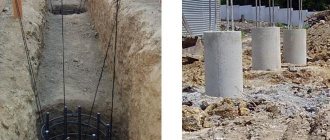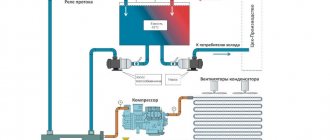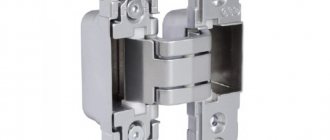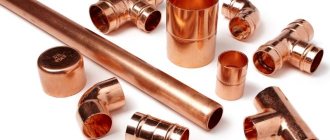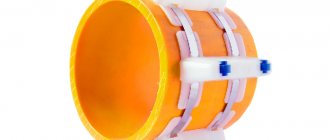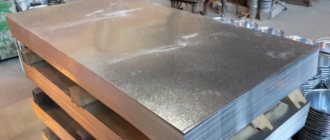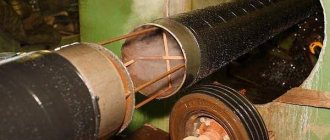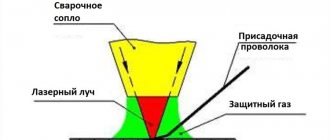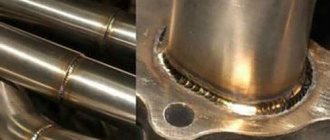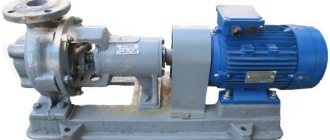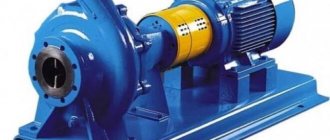In cases where the foundation for a future structure is being built in difficult soil conditions with a high risk of shifting, it is advisable to use bored piles with casing. This technology, which is recognized as one of the safest, is also used in cases where the future building is planned to be erected in an area characterized by dense buildings.
Bored pile foundation
The essence of technology
Casing pipes for bored piles (BPS), used in foundation construction, can differ in both their geometric parameters and design. The high reliability of foundation structures obtained using this technology is ensured by the fact that their basis, in addition to concrete, consists of frames for the manufacture of which metal reinforcement is used. The structure obtained using this method is not only securely fixed in the ground, but also itself demonstrates exceptionally high rigidity and stability.
Technological process for installing bored piles with casing
The technology for constructing bored piles is as follows:
- A well of the required diameter and depth approved by the project is drilled in a pre-selected location on the construction site, for which a special drilling rig is used.
- A casing pipe for piles is immersed into the resulting well. It is important that the depth to which such pipes are immersed is pre-calculated and approved by the project.
- The internal cavity of the pipe is freed from crumbled earth. To do this, various technical means are used (in particular, soil can be washed out of the pipe using water supplied under significant pressure).
- A reinforcement cage for a bored pile is lowered into the hole in the casing, cleared of crumbled earth.
- Concrete solution is poured into the internal cavity of the pipe, in which the reinforcement cage is placed. This process, in professional terms, is precisely called pile driving.
- After pouring the concrete, the casing pipes are removed from the ground section by section.
Naturally, the installation of bored piles is carried out using a technology that has a number of nuances. They must be taken into account during its practical implementation.
Well on site
- the presence of aquifers accessible for drilling;
- physical properties of soil rocks;
- type of drilling tool;
- the length of the casing, depending on the depth and direction of the well shaft.
After a geological survey of the area, the owner makes one of the following decisions:
- rent a UKB cable drilling rig and carry out the work on your own;
- hire a specialized team.
For independent actions, you can make a tripod of your own design. The triangular pyramid is made from available materials - wooden beams or metal profiles. You will need to stock up on a lifting mechanism to lower the casing pipe into the well and manipulate the projectile. The height of the drilling tower is determined by the size of a single casing fragment.
Advantages of bored piles
Among the many advantages of using BNS piles, several of the most significant can be identified, which include the following.
- The filling of such piles with concrete mortar is carried out quickly and efficiently.
- All stages of the technology for constructing bored piles are characterized by high safety for its performers.
- Thanks to the peculiarities of its construction technology, a cast-in-place pile is characterized by exceptionally high load-bearing capacity, resistance to mechanical loads and, accordingly, reliability.
- With the help of BNS piles, you can create reliable foundations even in weak and water-saturated soils.
- The use of this technology makes it possible to clearly monitor compliance with all requirements of design documentation, as well as accurately take into account the geological and engineering conditions in which this technological process is carried out.
- The technology under consideration makes it possible to extract large stones and boulders from the created well.
- When drilling wells using this technology, the soil is not subjected to vibration and dynamic loads.
- The turnover of the casing pipes used, which can be used repeatedly, is another important advantage of using this technology.
- All stages of the drilling operation can be controlled until the aquifer is reached.
- Complete protection of the walls of the well being created from soil collapse makes it possible to block dangerous horizons (such as quicksand).
- In wells produced using this technology, if the installation of bored piles involves the use of a reinforcement cage, there are no so-called necks, which significantly reduce the quality and reliability of the finished structure.
- The use of casing pipes for the installation of bored-type piles, as well as their further operation, is permitted in any climatic conditions.
Pouring the casing pipe with concrete solution
Recommendations for reducing the impact of method disadvantages
To prevent these shortcomings when applying the Kelly method, line personnel should be strictly required to comply with the provisions of technological maps , regulations, and work plans. In this case, defects and unproductive losses will be practically eliminated.
Do you need a technological map, regulations, PPR? Leave a request here
Today, unlike the 2000s, contractors cannot dictate their terms to customers, and are often forced to work under very strict price conditions. Therefore, the pace of work production is key; only high productivity can provide contractors with the opportunity to earn an acceptable income.
Therefore, it is important to properly prepare for the work:
— have serviced drilling rigs, prepared drilling tools, repaired casing pipes;
— assemble qualified, well-coordinated and motivated line personnel who trust the management of the drilling company;
— ensure the availability of design and initial permitting documentation, the scope of work, the readiness of the construction site, and the fulfillment of other conditions necessary for organizing rhythmic work;
— ensure the availability of the required number of reinforcement cages on the site, take control of the rhythmic supply of concrete mixture;
— organize fruitful interaction with representatives of the customer’s technical supervision on the issues of surveying critical structures, hidden work, and timely obtaining permits to perform certain technological operations.
Apply the Kelly Method to the construction of bored piles, build bigger and better, and earn income to develop more modern drilling technologies in construction.
Good luck to you, friends!
The nuances of using casing pipes
The use of casing pipes allows you to avoid such a negative phenomenon as shedding of earth from the walls of the well being created. Due to this, pipes of this type are actively used not only to create foundation structures in industrial and civil construction, but also to strengthen the walls of gas, water and oil wells. The structure of casing pipes is made up of individual sections of such products, connected to each other by welding or using special clamping devices (such as “Kato”, “Betono”, etc.).
After the reinforcement cage used for installing bored piles is placed in the inside of the casing pipes and the concrete solution is poured, the pipes themselves are removed. In some cases, if stipulated by the requirements of the project, the technology allows leaving the casing pipes in place.
Installation of reinforcement cage inside the casing pipe
Modern manufacturers produce casing pipes of various diameters, which makes it possible to optimally select such products for constructing wells for various purposes. International regulatory documents that stipulate requirements for the geometric parameters of casing pipes are the Leffer and Bauer standards. According to the requirements of these standards, the internal diameters of casing pipes for bored piles can be in the range of 620–2500 mm, and the external diameters range from 640 to 2580 mm.
Various techniques are used to lower the casing into a pre-prepared well. The most common are:
- driving of casing pipes, for which special vibration equipment is used;
- immersion of casing pipes using drilling, which can be carried out using percussion or rotational techniques.
Rotating casing installation
The use of the rotational technique involves first drilling a hole in the ground for the first section of the pipe, for which all necessary measurements are first taken. After the first section of the casing pipe is immersed in the prepared well, its second section is drilled, while also focusing on the geometric parameters of the corresponding section. Thus, by performing step-by-step drilling and immersing interconnected sections of casing pipes, the entire pipe structure for the bored pile is installed.
The essence of the impact method for installing casing pipes is that sections of pipes are simply driven into the ground, for which special equipment is used. The settlement of pipes, carried out using this technology for installing bored piles, can be carried out ahead of or with some lag in relation to the face being performed. It all depends on the characteristics of the soil in which the well is drilled (in particular, on its permeability).
Criterias of choice
To arrange the casing, you must have the following information: well depth, volume of water supply, diameter of the submersible electric pump, and the choice is also greatly influenced by the consumer’s financial resources. To determine which pipe is best for a well, consider several options for well sources for water supply.
- For water intake using a submersible electric pump from a shallow well (up to 30 m) of the Abyssinian type, it is best to use a polymer pipeline made of uPVC. Depending on financial capabilities, choose thin-walled products with a threaded socket connection or thick-walled ones with versatile external and internal threads.
- For wells in sand up to 60 m deep, a good option is thick-walled uPVC; for further depths up to 100 m, you can consider various methods with double casing made of polymers. A good option is to use a rigid PVC-U pipeline on the outside, and an elastic and less load-resistant HDPE shell on the inside.
- For depths above 100 m, it is rational to use a rigid metal casing, inside of which an elastic HDPE or rigid PVC-U pipeline can be placed.
Rice. 14 Appearance of PVC-U pipes
- In any case, when choosing a single-pipe or double-pipe casing, the composition of the soil, geological factors, and groundwater levels should be taken into account. It wouldn’t hurt to listen to the feedback of highly qualified specialists on the issue of casing.
- When purchasing HDPE products, you should be careful because the retail chain sells recycled technical polyethylene and food-grade primary material. Their main easily distinguishable difference is the color: a pipe made from recycled granules usually has a dark blue or rich blue color, sometimes there is a green tint. HDPE products made from primary raw materials, in accordance with GOST, have a bright blue or light blue color.
- Another criterion for determining a low-quality HDPE product is the smell of plastic. Oon may resemble the aroma of confectionery products, detergents, washing powder, etc. - all this indicates that the material is made from recycled granules. Pure virgin polyethylene is odorless and can be used in drinking water systems without harm to human health, while polyethylene from recycled materials can be used in water intake systems for technical needs.
- When choosing the diameter of the column, they are guided by the flow rate (performance) of the source and the dimensional parameters of the electric pump; for large volumes of water intake, they try to increase the diameter of the casing. The pump is selected so that its diameter is not less than 5 mm of the internal diameter of the wellbore; if a soft HDPE pipeline is used or water intake is carried out at great depths, a larger internal diameter of the column is selected taking into account the deformation of the channel when compressed by soil.
- The quality of a PVC-U threaded connection is determined as follows: screw a pipe into another or its branch pipe three turns and then move one of the parts to the sides - a large gap indicates a weak fastening. Such a connection has low tightness, and if it is necessary to dismantle the casing and remove the string from the wellbore, the thread will most likely be torn off.
Rice. 15 Well filters and cone plug
Areas of application of bored-type pile structures
It is impossible to answer the question of what bored piles are without listing their areas of application. Piles of this type are used for:
- erection of building structures in areas where the soil is prone to landslides;
- construction in areas characterized by high building density;
- carrying out construction work in areas with difficult geological conditions.
The use of bored piles in private housing construction
The use of pile structures, the walls of which are not additionally reinforced, is allowed in cases where the foundation is built in areas with rigid and hard soil, such as, for example, swelling-type clay soil. In addition, it is possible to install piles with unreinforced walls when their total length does not exceed 30 meters.
The technology for constructing bored-type piles is successfully used in cases where structures for various purposes are erected in places characterized by high seismic activity. In addition, bored pile structures are used to strengthen the foundations of already erected buildings, as well as to strengthen the soil in areas with a significant slope.
Features of the arrangement
After the well is cased, experts recommend pouring a small amount of clean river sand and granite or marble chips onto the bottom. They will serve as an additional filter. Then the water will be of very good quality.
Why is it necessary to use hard rock chips and river sand? If you pour ground sand or limestone gravel at the bottom of the source, the water will be contaminated with impurities invariably contained in these materials. They come out along with the liquid for a very long time, and during this period it will be cloudy and unsuitable for food purposes.
Water flows with loud sounds and interruptions, or does not flow from the source at all. These phenomena may occur for the following reasons:
- there is insufficient water level in the source;
- the filter is clogged or damaged;
- the supply pipe is sealed;
- The check valve of the pumping equipment has failed.
The need to install the head on the casing pipe. The main task of this element is to prevent foreign objects from entering the canal mouth. In addition, an important factor is that the head protects equipment and components from theft.
In general, by installing such a structure, the owner will solve the following issues:
- the likelihood of the upper part of the well freezing in winter will decrease;
- the source will be reliably sealed;
- the well's flow rate will increase;
- it will be possible to hang the pump and securely fasten the wiring.
The head is an important part of the well; it is a kind of cover that protects the entire structure from negative factors.
Today, manufacturers are trying to satisfy the client’s needs as fully as possible by implementing additional opportunities for using the well head. The most common options are:
- collet clamps and secret bolts to protect the structure from burglary;
- carabiners and eye bolts for hanging equipment;
- additional holes with spring protectors against bending for power cable outlet, etc.
